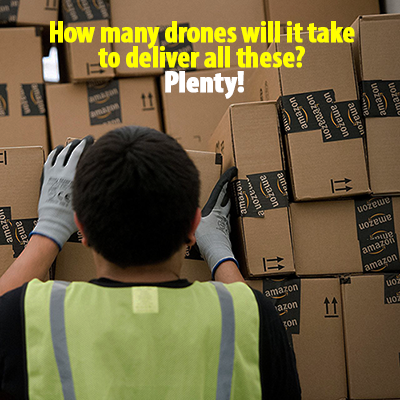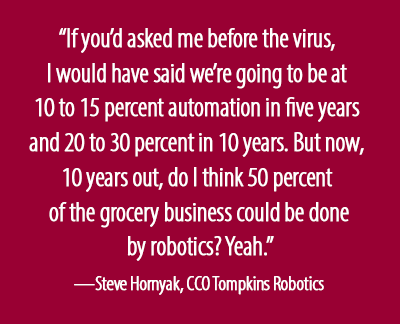
Here Comes Micro Fulfillment
Going Micro: Boon to Dying Malls and Warehouse Robots
Empty malls converted to last-mile warehouses forecast to $10B by 2026, while logistics robotics to flourish
“Micro Fulfillment Market is expected to have a cumulative opportunity worth ~$10B in next 6 years by 2026
with an installed base of ~2000 MFCs if the technology and concept remain permanent.”—LogisticsIQ
Robotics developers benefiting from Micro Fulfillment: Righthand Robotics, Kindred AI, Covariant,
OSARO, Plus One Robotics, XYZ Robotics, Fizyr, and Berkshire Grey.
Getting stuff the last mile
Visualize for a moment an Amazon van, stuffed to its dashboard with little brown boxes, offloading to a fleet of drones to be individually carried to doorsteps in my neighborhood. Hard to imagine those fleets of drones and their buzzing noise pollution getting a warm reception from my neighbors.
Worse than flocks of drones above might take place on our sidewalks far below. Another hard-to-imagine scene might be the sight of an autonomous Amazon Scout bumpily navigating the snow-snarled sidewalks in town, past groups of thugs and graffiti queens each malevolently eyeing the cute package delivery robot for a very nasty future.
Looted, wheels missing, overturned and sprayed with neon Krylon could be the fate of many. That is, of course, if Scout survives the online gauntlet of teenagers in their bedrooms snacking on KitKats while mirthfully hacking the robot’s navigation, sending them all to the Boston Fish Pier for a swim.
Getting stuff the last mile to a customer’s door via drones and autonomous sidewalk buggies has been dreamt about for years and has consumed lots of investment dollars, design time and fabrication. In the end, it may well be repurposing something old, like the abandoned and near-abandoned malls in most every town, that presents the best solution to last-mile deliveries.
As a recent study put it: “Online retailer Amazon has spent the past two decades luring shoppers out of stores and onto the internet, leading a retail transformation that has left dead malls in its wake. Now the Seattle-based company is buying more of those empty shopping centers, converting them into warehouses for processing deliveries to consumer doorsteps.
“Around the country, CBRE Group this year identified 24 projects where developers have turned closed malls and shopping centers into logistics properties since 2016, with almost 8 million square feet of retail either converted to or replaced with 10.9 million square feet of new industrial space.
“Among the advantages of converting malls to logistics facilities are their locations near population centers. That makes it easier to provide next-day or same-day delivery to customers, with easy access to highways and mass transit and water, sewer and parking systems already in place.
“Three years ago, CoStar analysts predicted that owners would need to upgrade, repurpose or demolish 1 billion square feet of dead malls and other U.S. shopping space to reduce vacancies and return retail property to normal levels of productivity.”
That somber statistic bears repeating: “1 billion square feet of dead malls.”
The newest hero of the last-mile delivery quest is being called “Micro Fulfillment”, which is hailed as “an effective way to meet the rising volumes, the changing geographical nature of e-commerce demand, and the growing desire for same-day delivery.”
And it’s plenty lucrative: The “Micro Fulfillment” Market is expected to have a cumulative opportunity worth ~$10B in next 6 years by 2026,” with 2022 being the year that the new hero touches the billion-dollar mark.
Millions more square feet of warehouse space ushering up from abandoned malls will mean more automation, more robots, more AMRs, more AVGs, plus more work for the factories where robots are built.
With e-commerce already hitting a torrid pace, our good buds from LogicticsIQ sent along a quick look at what’s shaping up for Micro Fulfillment in the near term…and the 75 players participating in the transformation. Micro Fulfillment – Need of the hour
Micro Fulfillment – Need of the hour
Industry giants such as Amazon, Walmart, Ocado, Kroger and Alibaba are driving the “best-in-class” e-commerce fulfillment strategy for the last decade. They are also investing in cutting-edge robotics and automation for their Customer Fulfillment Centers (CFCs) – that are continuously redefining target productivity and service levels.
But these centralized fulfillment centers are situated far away from the city and have an additional transportation cost along with considerably more delivery time as compared to consumer’s expectations, especially in grocery and F&B industry. Online grocery is already having a slim profit margin and micro-fulfillment has the ability to increase its margin and to make e-commerce accessible to a broader range of retailers because it cuts down major costs like
- The cost of storage, retrieval and picking (through automated MFC)
- The cost of the last mile delivery (through hyperlocal placement).
- The cost of real estate (through condensing fulfillment centers down into MFCs).
That’s why, Micro Fulfillment Center (MFC) is a perfect solution for urban warehouses with an approximated size between 5000 SF and 25000 SF that can meet the requirement of same day delivery through in-store picking or multiple last-mile delivery options. It can even be deployed at backside of the retail store, malls or basements. A typical MFC system is having 1-2 aisles Dry + 1-2 aisles Chilled, 5,000-8,000 totes 10-high storage to 24’ x 2-deep, 2 decanting stations and 2-4 pick stations with each station picking at 700-800 UPH.
Jack Peck, president of FastFetch Corp., offers a look at the value and growing use of Micro Fulfillment centers
Top Factors
- It is estimated that online grocery will contribute more than 10% of overall grocery sale in US by 2025.
- It is expected that consumers will continue with habit of buying online grocery developed during pandemic.
- Delivery option may vary as Home Delivery, In-Store Pick Up, Curb side Pickup, Locker Delivery etc.
- Urban warehouses with automation will be key to meet this demand with same day delivery expectations.
- Delivery Fee is the one of the key factors to decide the digital channel.
- Key to make online grocery business more profitable as compared to current scenario of either net loss or thin profit margin
Micro Fulfillment Advantages vs Customer Fulfillment Center (CFC)
- Low CapEx and TCO; Even OpEx model works quite well like pay per pick or RaaS
- Lesser time to build and install (4-8 weeks)
- Eliminates the requirement of Conveyors
- Faster delivery for end-customer (same day delivery)
- Low cost for labor (automated fulfilment) and better last mile delivery (closer to end-customer)
- Home Delivery and In-Store Shopping, both options are open through In-store Fulfillment
- Direct relationship between retailer and customer. No or minimum 3rd party involvement for this customer experience
Micro Fulfillment Market Trends
Micro Fulfillment Market has been the most important and emerging trend during pandemic (covid-19) coming out from some bigger trends like eGrocery Growth, Urban Warehouses and Automated Cold Storages.
Huge investment in start-ups like Takeoff Technologies ($86M+), Fabric ($136M+), Attabotics ($82M+), Exotec Solutions ($111M+) and Alert Innovation are witnessing this growth along with presence of existing traditional players like Dematic, Swisslog, Knapp, OPEX Corporation, Muratec, AutoStore, Honeywell Intelligrated and Vanderlande.
Retailers such as Walmart, Amazon, Kroger, Woolworths, Amazon, Ocado, Carrefour, Uniqlo, Meijer, H-E-B, Albertsons, Majid Al Futtaim and Ahold Delhaize have already started adopting and implementing these new technologies during pandemic.
Apart this, piece-picking robots suppliers like Berkshire Grey, Righthand Robotics, Kindred AI, Covariant, OSARO, Plus One Robotics, XYZ Robotics, Fizyr have established a new attractive capability for order picking in ecommerce fulfillment to transfer the good-to-person (G2P) systems into good-to-robot (G2R) systems.
The Micro Fulfillment Market is expected to grow with a CAGR of ~60% between 2020 and 2026 with a maximum market share from U.S. Recently, developments have been started in Europe and APAC as well for countries like U.K., France, Japan and Australia. Even there are some order intake in UAE, Saudi Arabia and Israel from middle east region as well.
Grocery is going to be the main contributor for this market with 70%-80% market share although general merchandise and other industries are also going to adopt the market very soon.
Coming to MFC system architecture and technologies, AutoStore is an old and proven technology with hundreds of installations in ecommerce fulfullment including the recent partnership with Swisslog and H-E-B for micro fulfillment center in U.S. but they are going to face a very good competition in MFC space from new players like Takeoff Technologies, Fabric, Exotec Solutions, Attabotics and Alert Innovation.
Established system integrators like Dematic, Honeywell Intelligrated, Vanderlande and Knapp are using the traditional shuttle and ASRS systems which are good and already proven for big fulfillment centers but not 100% ideal for micro fulfillment yet.
At the same time, Attabotics, Alert Innovation, and Exotec are using emerging 3D technologies having good architecture specific to MFC with high density and no point of failure but it will too early to say anything as there are only few installations and not 100% proved yet.
Apart this, software is going to be the main differentiator and value add for MFC systems as some suppliers are having their in-house software capabilities and others are having a partnership to do the needful. As per our discussion with technology suppliers and industry experts, every technology and architecture are having its own advantage and disadvantage depending upon the grocery store’s location, current requirement, capital expenditure, fear of digitalization and automation from big players, and insecurity related to its consumers’ information.
Key Players in Micro-Fulfillment Market Ecosystem:
- Technology Providers: Takeoff Technologies, Fabric, Alert Innovation, Exotec Solutions, Autostore, Opex Corporation, Dematic, Attabotics, Ocado, Addverb Technologies, Vanderlande, Honeywell Intelligrated
- AutoStore Partners: Swisslog, Dematic, AM Logistic Automation, Okamura, Pulse Integration, LG CNS, Fortna, Kuecker Logistics Group, Hörmann Logistik, ALStef, Bastian Solutions, TKSL, Lalesse Logistic Solutions, Element Logic
- Other Partners & Key Players: AHS, Muratec, Knapp, FoodX Technologies, S&H Systems, Conveyco, Dexter, Tompkins Robotics, NanoFC, Geekplus, Myrmex, Locai, HDS, i-collector, Storojet, Grey Orange, G.I.Eicom
- End Customer: Sedano’s, Walmart, Nordstorm, Ahorramas, Meijer, Uniqlo (Fast Retailing), Cdiscount, Carrefour, Leclerc, PepsiCo, H-E-B, Alpen Co. Ltd., Albertsons, Ahold Delhaize, Wakefern Food Corp., Majid Al Futtaim, Big Y, Woolworths, Loblaws, Associated Wholesale Grocers (AWG), Korger, Sobeys, Amazon, Fresh Direct, Super Farm, Rami Levy
To continue with LogisticsIQ see: Micro Fulfillment Analysis
